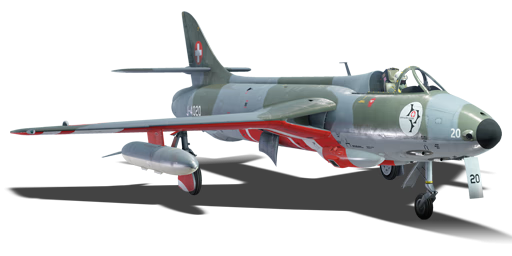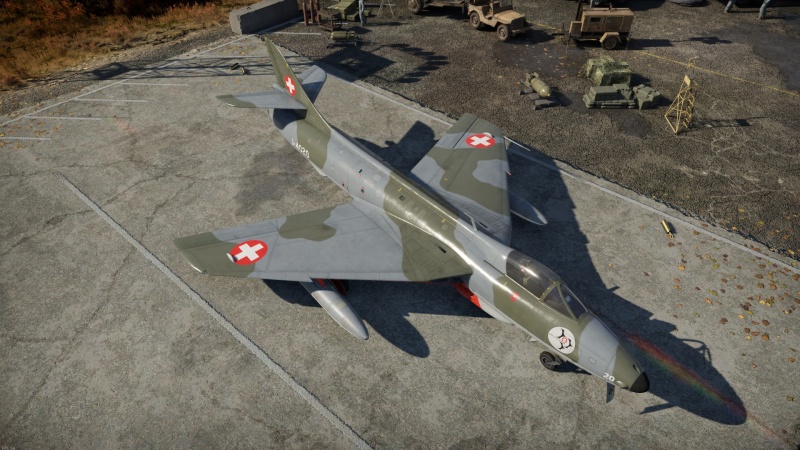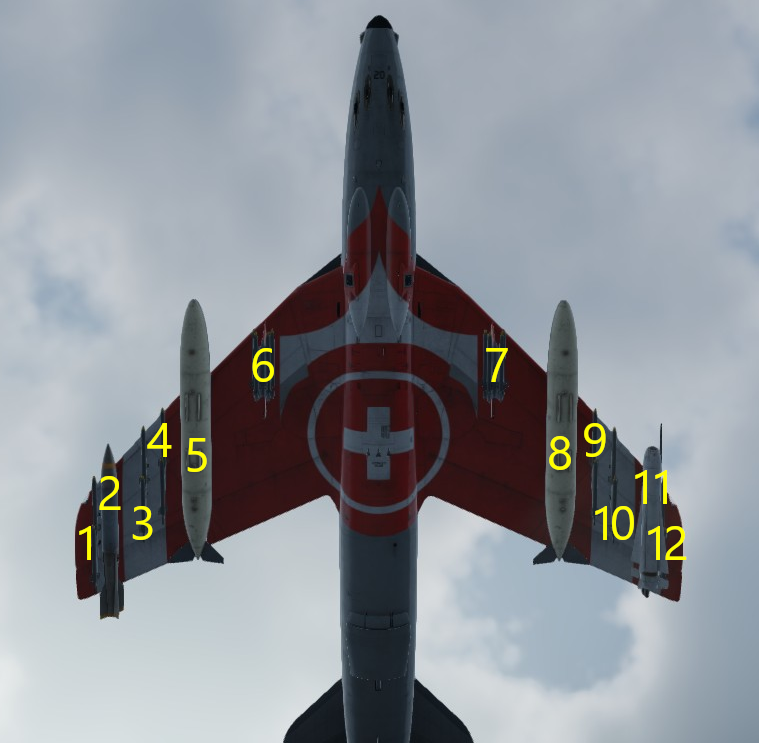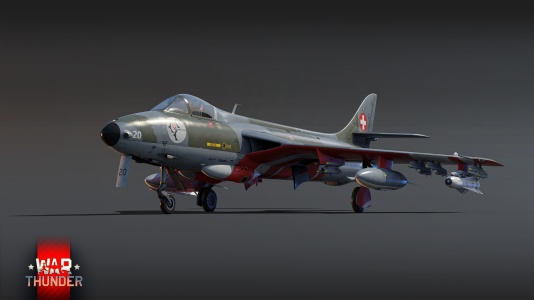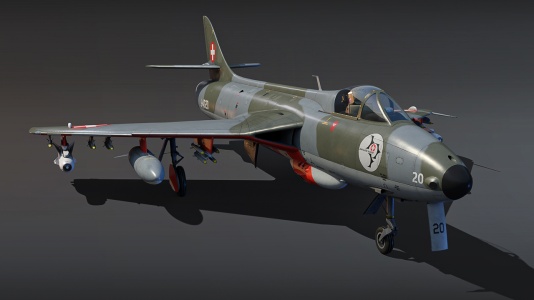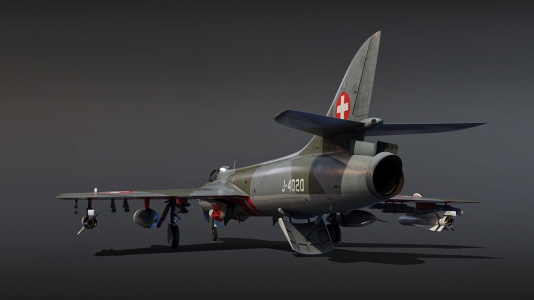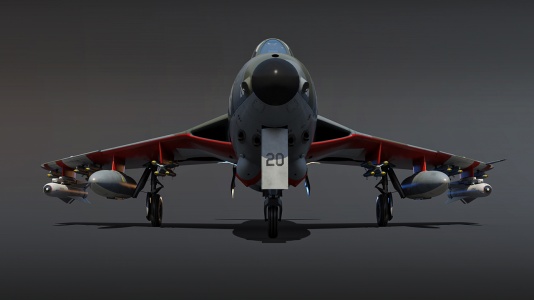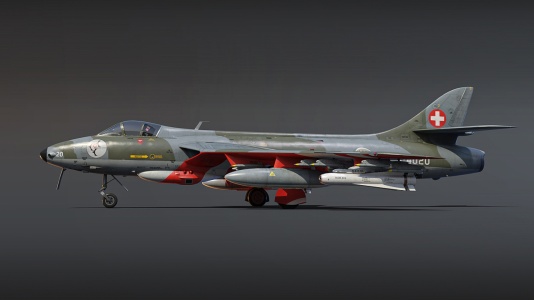Hunter F.58 (Germany)
| This page is about the squadron jet fighter Hunter F.58 (Germany). For other versions, see Hunter (Family). |
Contents
Description
The ◌Hunter F.58 with a tail number of J-4020, was one of the Hawker Hunters in Swiss Air Force service and a member of the Patrouille Suisse ("Swiss Patrol") Aerobatic Team. This aircraft with factory code 41H-691768 was first flown on 4th February 1958, and subsequently joined the Swiss Air Force during the 1960s alongside another 87 F.58 (exported F.6). These jets were further upgraded under the KAWEST (Kampfwertsteigerung; Increased Operational Performance) in 1964 with RWR, an ECM pod, and chaff dispensers,as well as capabilities to launch AIM-9 and AGM-65B, turning it into a multi-role fighter for the Swiss until they were replaced by the F-5E. The remaining fleet of Hunters with the special livery of the Patrouille Suisse eventually retired in 1994 and the jet represented in-game is currently displayed at the northern corner of Dübendorf Airfield on the outskirts of Zurich.
The jet was introduced in Update "Sky Guardians" as a squadron vehicle in the German aviation tech tree and introduced Switzerland into the game. Unlike the FGA.9 or F.6 in the British tech tree, the F.58 has access to more advanced missile options including the AIM-9P and AGM-65B, as well as RWR and countermeasures to fend against enemy acquisition. Although it will face more advanced supersonic jets which sometimes have radar-guided missiles or all-aspect AAMs, if picking enemies which has depleted their energy or lacking situation awareness, the ADEN autocannons and missiles will make very short work of them, while the Hunter can fly away from the battlefield with its good energy retention and countermeasures onboard.
General info
Flight performance
The Hunter F.58 performs similar to other Hunters, particularly the Hunter FGA.9, as they host the same Rolls-Royce Avon Mk.207 powerplant. As with most other Hunters, the F.58 handles poorly at low speeds, thus, turning and rate fighting is not advised. However, thanks to a decent acceleration, the Hunter can reach speeds exceeding 800 km/h. The Hunter at higher speeds possess quite a decent turn rate, able to maintain 9-10 Gs. Coupled with the excellent energy retention of this aircraft, the Hunter F.58 can be a formidable aircraft in the hands of a competent pilot.
| Characteristics | Max speed (km/h at 0 m - sea level) |
Max altitude (metres) |
Turn time (seconds) |
Rate of climb (metres/second) |
Take-off run (metres) | |||
|---|---|---|---|---|---|---|---|---|
| AB | RB | AB | RB | AB | RB | |||
| Stock | 1,138 | 1,132 | 15500 | 25.5 | 26.3 | 53.3 | 46.2 | 820 |
| Upgraded | 1,158 | 1,148 | 24.6 | 25.0 | 88.5 | 69.6 | ||
Details
| Features | |||||
|---|---|---|---|---|---|
| Combat flaps | Take-off flaps | Landing flaps | Air brakes | Arrestor gear | Drogue chute |
| ✓ | ✓ | ✓ | ✓ | X | ✓ |
| Limits | ||||||
|---|---|---|---|---|---|---|
| Wings (km/h) | Gear (km/h) | Flaps (km/h) | Max Static G | |||
| Combat | Take-off | Landing | + | - | ||
| 1,225 | 450 | 603 | 581 | 465 | ~14 | ~6 |
| Optimal velocities (km/h) | |||
|---|---|---|---|
| Ailerons | Rudder | Elevators | Radiator |
| < 850 | < 600 | < 690 | - |
Engine performance
| Engine | Aircraft mass | ||||
|---|---|---|---|---|---|
| Engine name | Number | Basic mass | Wing loading (full internal fuel) | ||
| Rolls-Royce Avon Mk.207 | 1 | 6,209 kg | 240 kg/m2 | ||
| Engine characteristics | Mass with internal fuel (no weapons load) | Max Gross Weight | |||
| Weight (each) | Type | 3m fuel | 13m fuel | ||
| 1,175 kg | Axial-flow turbojet | 6,620 kg | 7,578 kg | 10,216 kg | |
| Maximum engine thrust @ 0 m (RB/SB) | Thrust to weight ratio @ 0 m (100%) | ||||
| Condition | 100% | WEP | 3m fuel | 13m fuel | MGW |
| Stationary | 4,272 kgf | - | 0.65 | 0.56 | 0.42 |
| Optimal | 5,229 kgf (1,225 km/h) |
- | 0.79 | 0.69 | 0.51 |
Survivability and armour
Like other Hunter variants, the Hunter F.58 has quite a survivable airframe. Being able to withstand hits from medium-calibre cannon fire, even being able to withstand hits to critical components such as the wings, engine, etc. However, like most other aircraft, the Hunter is not a bunker. Large-calibre cannons like ADENs will easily tear your plane apart.
The Hunter, like all other variants, feature only a 64 mm bullet proof glass in front of the pilot, with a 12.7 mm steel plate behind the pilot.
This Hunter, however, unlike any other Hunter variant, features 60 countermeasures for use against guided munitions.
Modifications and economy
Armaments
| Ballistic Computer | ||||
|---|---|---|---|---|
| CCIP (Guns) | CCIP (Rockets) | CCIP (Bombs) | CCRP (Bombs) | Lead indicator |
| |
|
|
|
|
Offensive armament
The Hunter F.58 (Germany) is armed with:
- 4 x 30 mm ADEN cannons, chin-mounted (150 rpg = 600 total)
- 60 x countermeasures
Suspended armament
The Hunter F.58 (Germany) can be outfitted with the following ordnance:
| 1 | 2 | 3 | 4 | 5 | 6 | 7 | 8 | 9 | 10 | 11 | 12 | ||
|---|---|---|---|---|---|---|---|---|---|---|---|---|---|
| 200 kg Sprengbombe bombs | 1, 2* | 1, 2* | |||||||||||
| 400 kg Sprengbombe bombs | 1 | 1 | |||||||||||
| 450 kg Sprengbombe 68/70 bombs | 1 | 1 | |||||||||||
| FeBb Napalmbombe incendiary bombs | 1 | 1 | |||||||||||
| Flz.-Rakete Oerlikon rockets | 2* | 2 | 2 | 4 | 4 | 2 | 2 | 2* | |||||
| Flz Lwf 63/80 missiles | 1 | 1 | |||||||||||
| Flz Lwf LB 82 missiles | 1 | 1 | |||||||||||
| 150 gal drop tanks | 1 | 1 | |||||||||||
| Maximum permissible weight imbalance: 500 kg | |||||||||||||
| * Dual bombs on hardpoints 2/11 cannot be equipped in conjunction with rockets on hardpoints 1/12 respectively | |||||||||||||
| Default weapon presets | |
|---|---|
| |
Usage in battles
The Hunter F.58 is a transonic aircraft in level flight but can reach supersonic speed in a dive (but rated at exactly M1.0 before structural failure). That means that it is faster than other subsonic aircraft (one of the fastest subsonic jet, just behind the duo "Jump-jet": Yak-38M and US Harriers) it will face, but slower than early supersonic aircraft like the F-100D and the MiG-19PT. Thanks to the upgrades by Swiss in 1964, the F.58 received more self-defense equipment such as all-aspect RWR and 60 countermeasures onboard - it can be said that the jet is old but not obsolete.
Air - the Swiss Patrol
A thumb of rule for jet fighters is that: always maintain your energy for any situation. Thanks to its excellent design and sufficiently high engine power for such a huge jet, the energy retention is almost an order of magnitude higher than supersonic aircraft, which bleed speed in sharp turns, this can be both a blessing and a curse, when in a prolonged turning engagement, your energy retention advantage will allow you to pull away from a supersonic at the end of a turn; however, a plane such as the F-100D can trade its AoA with its speed to stay on your tail. In many situations, when you have a supersonic on your tail, making them overshoot is very difficult, but if you can, the Flz Lwf 63/80 will make short work of them as finishing them off from afar is always better than being forced into a dogfight (where most subsonic fighters don't have countermeasures). When facing subsonic aircraft, simply outrun them with your superior speed and gain sufficient distance for a return; try not to engage in a turnfight with subsonic aircraft such as MiGs (15 and 17, both Russian and Chinese variants) and late variants of the F-86 Sabre (starting from F-86F-25 which feature slats; while F-86K or Canadair Sabres have better engine to keep up with Hunter), as they are often able to best you in a dogfight, especially at low speeds, where the Hunter really shows its weaknesses - its huge size and worse manoeuvrability at such speed. The plane, under most circumstances, does not rip it's wings, even under extended, high G turns; although if you combine a 9-10 G turn and roll or yaw, the plane can rip. Unlike some other planes, you have almost no chance of making it back to the airfield with a broken wing. This Hunter also has access to the Flz Lwf 63/80 air-to-air missiles, which work as AIM-9P Sidewinder; for players who have been used to AIM-9E or SRAAM on other Hunters, the 63/80 can make sure careless players who don't check their 6 o'clock meet their end quickly.
Another note for the Hunter is that, thanks to the upgrades mentioned before, players can now more confident when facing later supersonic jets with SARH missiles like F-4C or MiG-21S. This will also be the good time to learn about the characteristics of SARH missiles - with up to 60 chaffs available, flying sideways and dive for terrain while dispensing chaffs can make sure enemy SARH missiles will likely uncage from yourself.
Ground - the Lesser Ground-pounder
While Swiss purchased the F.58 variant which was based on the F.6 with ground-attack capabilities, likely due to the revised avionics onboard or the need for drop tanks, the payload options is in fact relatively less than his Commonwealth cousins: only the outer-board pylon could carry bombs, unguided rockets and the Flz Lwf LB 82 (AGM-65B) missiles. Although there are alternatives with more payload such as F-84F or with more AGMs like G.91 R/3, if players insist to bring out Hunter, the varieties of bombs ranging from 200 to 450 kg, as well as unguided rockets and napalms can still make sure it can score some victories at cleared skies (cleared from SPAAs or enemy interceptors); due to the lack of ballistic computer, players will still have to learn the trajectory of different payloads in test flights. As mentioned before, what makes F.58 stand out is the LB 82 missiles, players of USAF tree will be happy to learn that it is the other name of AGM-65B Maverick but under Swiss designation; this also makes it the second-earliest jet to equip the Maverick stand-off missiles (after Israel's 9.3 Ayit with AGM-65A's) against high-threat targets such as Soviet MBTs or SPAA with missile systems onboard. Be sure to utilize the upgraded avionics for better situational awareness from different threats - the speed of the Hunter is still valuable even at its tier with supersonic jets.
Pros and cons
Pros:
- Sufficient ammo pool to take down multiple targets
- One of the fastest subsonic jets, retains decent manoeuvrability at higher speeds
- Good energy retention for energy fights against subsonic or early supersonic jets
- Access to more advanced missiles for both A2A/A2G missions
- Advanced avionics over all its Hunter cousins
- All-aspect RWR for situational awareness
- Flares/chaff to help counter those types of missiles
Cons:
- Huge target, can be easy prey to enemy gunfire
- Not manoeuvrable below 600 km/h
- Relatively limited payload options due to pylon layouts
- Due to its advanced capabilities will face off against supersonic jets often, which renders the Hunter's subsonic capabilities futile
History
Describe the history of the creation and combat usage of the aircraft in more detail than in the introduction. If the historical reference turns out to be too long, take it to a separate article, taking a link to the article about the vehicle and adding a block "/History" (example: https://wiki.warthunder.com/(Vehicle-name)/History) and add a link to it here using the main template. Be sure to reference text and sources by using <ref></ref>, as well as adding them at the end of the article with <references />. This section may also include the vehicle's dev blog entry (if applicable) and the in-game encyclopedia description (under === In-game description ===, also if applicable).
Media
- Skins
- Images
- Videos
See also
- Related development
External links
| Hawker Aircraft Limited | |
|---|---|
| Biplane fighters | |
| Fury | Fury Mk I · Fury Mk II |
| Nimrod | Nimrod Mk I · Nimrod Mk II |
| Scout plane | Osprey Mk IV |
| Piston fighters | |
| Hurricane | Hurricane Mk I/L · Hurricane Mk.I/L FAA M · Sea Hurricane Mk IB · Sea Hurricane Mk IC · Hurricane Mk IIB/Trop · Hurricane Mk IV |
| Typhoon | Typhoon Mk Ia · Typhoon Mk Ib · Typhoon Mk Ib/L |
| Tempest | Tempest Mk V · Tempest Mk V (Vickers P) · Tempest Mk II |
| Fury | Sea Fury FB 11 |
| Jet fighters | |
| Hunter | Hunter F.1 · Hunter F.6 · Hunter FGA.9 · ◌Hunter F.58 |
| Sea Hawk | Sea Hawk FGA.6 |
| Harrier | Harrier GR.1 · Harrier GR.3 |
| Export | ▄Hurricane Mk I/L · ▂Hurricane Mk IIB · J34 · ◄Sea Hawk Mk.100 · AV-8A · AV-8C |
| Captured | ▀Tempest Mk V |
| Germany jet aircraft | |
|---|---|
| Ar 234 | Ar 234 B-2 · Ar 234 C-3 |
| He 162 | He 162 A-1 · He 162 A-2 |
| Ho 229 | Ho 229 V3 |
| Me 163 | Me 163 B · Me 163 B-0 |
| Me 262 A | Me 262 A-1a · Me 262 A-1a/Jabo · Me 262 A-1a/U1 · Me 262 A-1/U4 · Me 262 A-2a |
| Me 262 C | Me 262 C-1a · Me 262 C-2b |
| Tornado | ◄Tornado IDS WTD61 · ◄Tornado IDS MFG · ◄Tornado IDS ASSTA1 |
| West Germany | Alpha Jet A |
| USA | ◄F-84F |
| ◄CL-13A Mk 5 · ◄CL-13B Mk.6 · ◄F-86K | |
| ◄F-104G | |
| ◄F-4F Early · ◄F-4F | |
| USSR | ◊MiG-15bis |
| ◊MiG-19S | |
| ◄MiG-21 SPS-K · ◊MiG-21MF · ◊MiG-21bis-SAU · ◊MiG-21 "Lazur-M" | |
| ◊MiG-23BN · ◊MiG-23MF · ◊MiG-23MLA | |
| ◊MiG-29 · ◄MiG-29G | |
| ◊Su-22UM3K · ◊Su-22M4 | |
| ◊IL-28 | |
| Poland | ◊Lim-5P |
| Britain | ◄Sea Hawk Mk.100 · ◌Hunter F.58 (Swiss) |
| Italy | ◄G.91 R/3 · ◄G.91 R/4 |
| Squadron aircraft | |
|---|---|
| USA | A-4E Early |
| Germany | Me 262 A-1a/U1 · ◌Hunter F.58 |
| USSR | Su-22M3 |
| Britain | Firecrest · Sea Harrier FRS.1 |
| Japan | ▄F-5E FCU |


